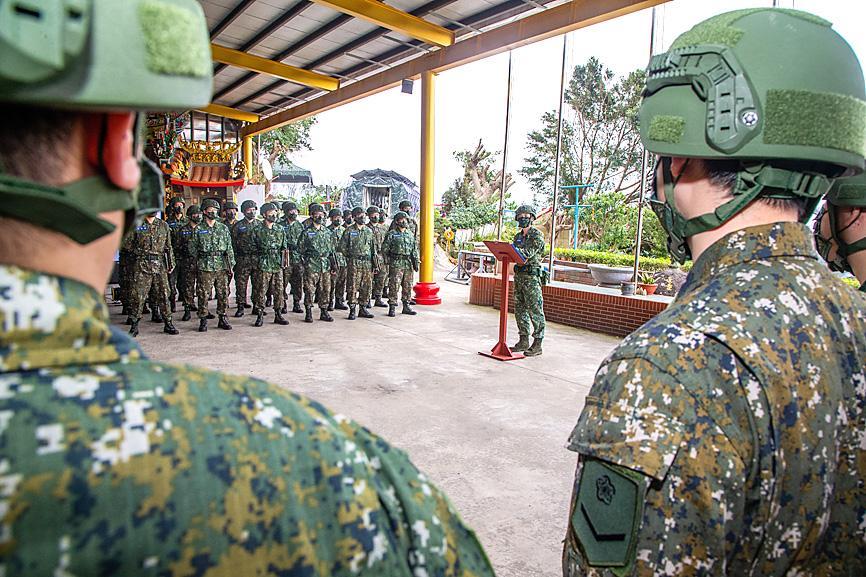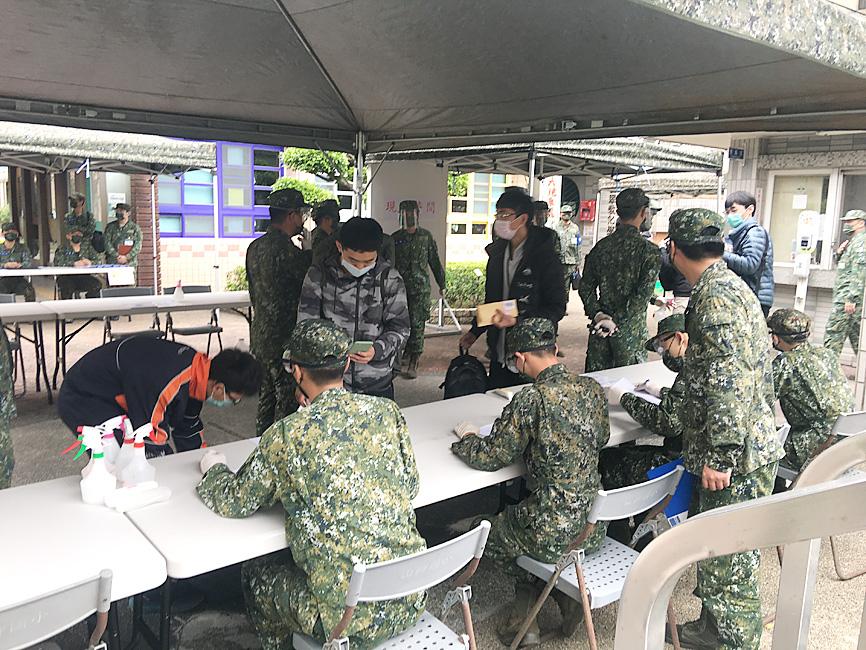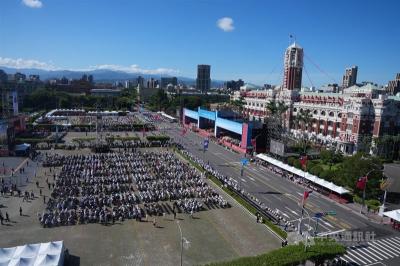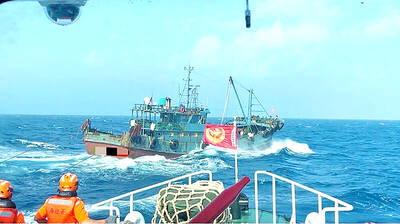The first batch of about 500 reservists yesterday reported to Shanjiao Elementary School in Taoyuan’s Lujhu District (蘆竹) to undergo a new, more intensive 14-day reservist training program.
The program is operating in a scenario of defending the beach near New Taipei City’s Linkou District (林口), said 203 Brigade Third Infantry Battalion Deputy Commander Major Chen Ming-chung (陳明中).
All reservists would train for about 10 hours a day, including a two-hour, 10km nighttime combat march, for a total of 136 hours over 14 days, Chen said.

Photo: Military News Agency
Reservists said that the schedule — described by local media as “the toughest reservist training in history” — was daunting, but that the invasion of Ukraine by Russia demonstrates that tougher reservist training is necessary.
No one knows when China might attack Taiwan, underscoring the necessity for a reservist force capable of fighting, one reservist said.
Reservists must be capable of fighting when called upon, as demonstrated by the suddenness of the Russian invasion of Ukraine, another said.

Photo: Hsieh Wu-hsiung, Taipei Times
A reservist surnamed Chou (周) said that the military should first step up the training for active soldiers.
It felt “odd” that the military would step up training for reservists, who have never undergone full military training to begin with, he said.
Commenting on concerns about reservists’ nutrition during the march, the Ministry of National Defense said that they would be provided with dried rations and ready-to-eat meal packages.
Reservists would only be allowed to use their mobile phones twice a day, from 7pm to 8pm and from 9pm to 10pm, during the two weeks.
All of the Central Epidemic Command Center’s COVID-19 pandemic prevention regulations would be observed, said Lee Meng-han (李孟涵), the battalion’s medical officer.
The reservists were yesterday given a quick recap of camp regulations, were assigned patrol and guard duties, and underwent disaster-prevention drills and first-aid training, their schedule showed.
Today and tomorrow, they would revisit military occupational specialty training, arms disassembly and assembly, and combat first-aid, the schedule showed.
All units under company level would be practicing marksmanship and combat from day four to day 10.
Days 11 to 13 would focus on battalion-level combat training, while reservists would on the last day service their arms and return them before the official conclusion of the program.
The new training regimen would be tested in the first three quarters of this year on about 15,000 reservists at 24 battalions and one company, Ministry of National Defense All-out Defense Mobilization Agency Director Yu Wen-cheng (俞文鎮) said on Wednedsay.
It was devised after the military in 2020 said that it wanted to ensure that the nation’s reserve force could more reliably back up regular forces due to increased Chinese military maneuvers around Taiwan.
Additional reporting by CNA

POLITICAL AGENDA: Beijing’s cross-strait Mid-Autumn Festival events are part of a ‘cultural united front’ aimed at promoting unification with Taiwan, academics said Local authorities in China have been inviting Taiwanese to participate in cross-strait Mid-Autumn Festival celebrations centered around ideals of “family and nation,” a move Taiwanese academics said politicizes the holiday to promote the idea of “one family” across the Taiwan Strait. Sources said that China’s Fujian Provincial Government is organizing about 20 cross-strait-themed events in cities including Quanzhou, Nanping, Sanming and Zhangzhou. In Zhangzhou, a festival scheduled for Wednesday is to showcase Minnan-language songs and budaixi (布袋戲) glove puppetry to highlight cultural similarities between Taiwan and the region. Elsewhere, Jiangsu Province is hosting more than 10 similar celebrations in Taizhou, Changzhou, Suzhou,

The Republic of China (ROC) is celebrating its 114th Double Ten National Day today, featuring military parades and a variety of performances and speeches in front of the Presidential Office in Taipei. The Taiwan Taiko Association opened the celebrations with a 100-drummer performance, including young percussionists. As per tradition, an air force Mirage 2000 fighter jet flew over the Presidential Office as a part of the performance. The Honor Guards of the ROC and its marching band also heralded in a military parade. Students from Taichung's Shin Min High School then followed with a colorful performance using floral imagery to represent Taiwan's alternate name

COGNITIVE WARFARE: Chinese fishing boats transmitting fake identification signals are meant to test Taiwan’s responses to different kinds of perceived incursions, a report said Chinese vessels are transmitting fake signals in Taiwan’s waters as a form of cognitive warfare, testing Taipei’s responses to various types of incursions, a report by the Institute for the Study of War said on Friday. Several Chinese fishing vessels transmitted fake automatic identification system (AIS) signals in Taiwan’s waters last month, with one mimicking a Russian warship and another impersonating a Chinese law enforcement vessel, the report said. Citing data from Starboard Maritime Intelligence, the report said that throughout August and last month, the Chinese fishing boat Minshiyu 06718 (閩獅漁06718) sailed through the Taiwan Strait while intermittently transmitting its own AIS

CHINESE INFILTRATION: Medical logistics is a lifeline during wartime and the reported CCP links of a major logistics company present a national security threat, an expert said The government would bolster its security check system to prevent China from infiltrating the nation’s medical cold chain, a national security official said yesterday. The official, who wished to stay anonymous, made the remarks after the Chinese-language magazine Mirror Media (鏡周刊) reported that Pharma Logistics (嘉里醫藥物流) is in charge of the medical logistics of about half of the nation’s major hospitals, including National Taiwan University Hospital and Taipei Veterans General Hospital. The company’s parent, Kerry TJ Logistics Co (嘉里大榮物流), is associated with the National Committee of the Chinese People’s Political Consultative Conference (CPPCC) and the Chinese People’s Liberation Army (PLA), the